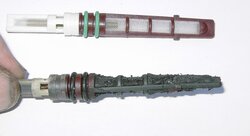91explorer1009
Well-Known Member
- Joined
- January 14, 2004
- Messages
- 271
- Reaction score
- 0
- City, State
- NJ
- Year, Model & Trim Level
- 91 sport
Ok, I need some general info here. How hard is it and what special tools does it take to install a new condenser on my 91 ex, with a tranny cooler? I was at a friend of a friends shop and he leak dye tested my system for me and there was a lot of leaks in the condenser, and a leak behind the compressor going into the tubes. I know I can replace the rings inside the connection on the back of the compressor, but don't know what it takes to put in a new condenser. I saw them on ebay for around 100-150$. He quoted me 285 for a new one. And 500 for the job total with that incl. I said I would think about it, and left. Would I have to take out the rad. and fan and belt and all or what.? Cause I dont know if I want to mess with those rusty metal lines on the rad. Please let me know what you think guys. I am pretty good mechanically, change oil, minor things, etc. I have recharged the system in the past by myself. Can I just swap it out from the front behind the grill? This would save me a ton of money, if I could do this myself. And what is a quick connect and how do I get tham off if I need to? Thanks in advance, I really need your opinions. Hot in Jersey :fire:















